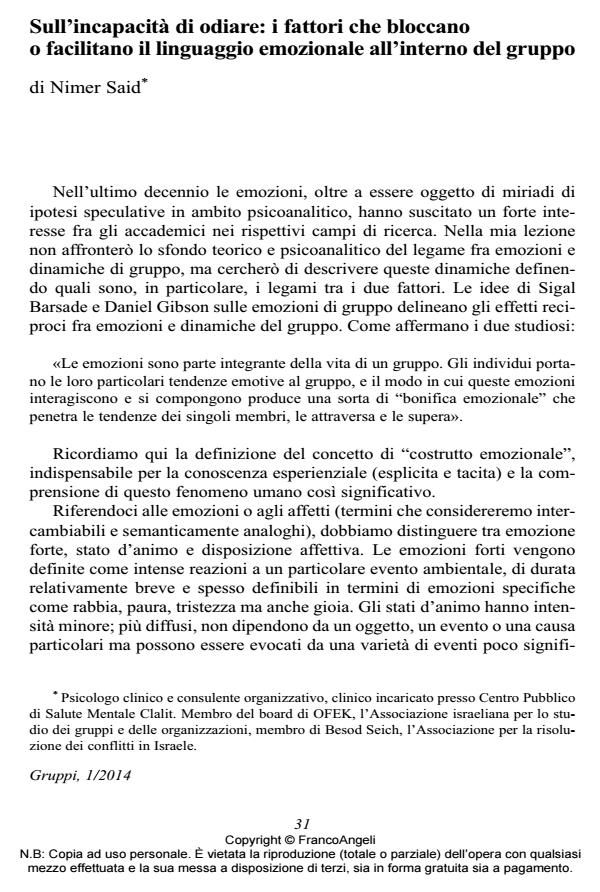On the inability to hate: the factors that block or facilitate emotional language within groups
Journal title GRUPPI
Author/s Nimer Said
Publishing Year 2014 Issue 2014/1
Language Italian Pages 6 P. 31-36 File size 64 KB
DOI 10.3280/GRU2014-001004
DOI is like a bar code for intellectual property: to have more infomation
click here
Below, you can see the article first page
If you want to buy this article in PDF format, you can do it, following the instructions to buy download credits

FrancoAngeli is member of Publishers International Linking Association, Inc (PILA), a not-for-profit association which run the CrossRef service enabling links to and from online scholarly content.
Although emotions are an essential part of a group’s life and individuals bring their own, particular emotional tendency to the group, the way in which these emotions interact and are formed can produce a sort of “emotional restoration” that penetrates, experiences and goes beyond each single member’s tendencies. In the approach we call top-down, the group is seen as a whole, and the group conductors try to grasp the dimensions of the elusive emotions that arise from group dynamics, focusing on the group as a holistic entity that influences the members’ feelings and behavior. In the bottom-up approach, on the other hand, the group’s emotions are seen as a sum of its parts, evaluating the way in which each member’s emotions are combined together, thus creating an emotion at a group level. The presented group belongs to the work of mental health services in an ethnically mixed city in Galilee. It was composed of 12 members: 8 men (4 Arabs and 4 Jews) and 4 women (2 Arabs and 2 Jews). The group, which worked for one and a half years, aimed at helping individuals with social disorders mainly caused by relational problems and whose psychiatric diagnoses ranged from mild affective and anxiety disorders to adjustment disorders. Before forming the group, the staff mainly discussed whether the Arab patients would be able and willing to take part in this kind of group therapy, since former experiences had revealed reluctance on the part of Arab patients to avail themselves of this kind of professional help. The staff asked themselves whether group therapy would produce any clinical benefits in the case of patients with different nationalities, with bi-national conflicts and tensions. Through the description of how the group evolved, it is observed that in the last period the participants went through greater processing of the differences and heterogeneity in their emotions. At the same time, they were able to work through active, negative and direct feelings such as anger, resentment, and even hatred: indeed, the latter were expressed more openly and yet in a more controlled fashion.
Keywords: Group, emotions, affective disposition, top-down approach, bottomup approach, emotional contagion.
Nimer Said, Sull’incapacità di odiare: i fattori che bloccano o facilitano il linguaggio emozionale all’interno del gruppo in "GRUPPI" 1/2014, pp 31-36, DOI: 10.3280/GRU2014-001004